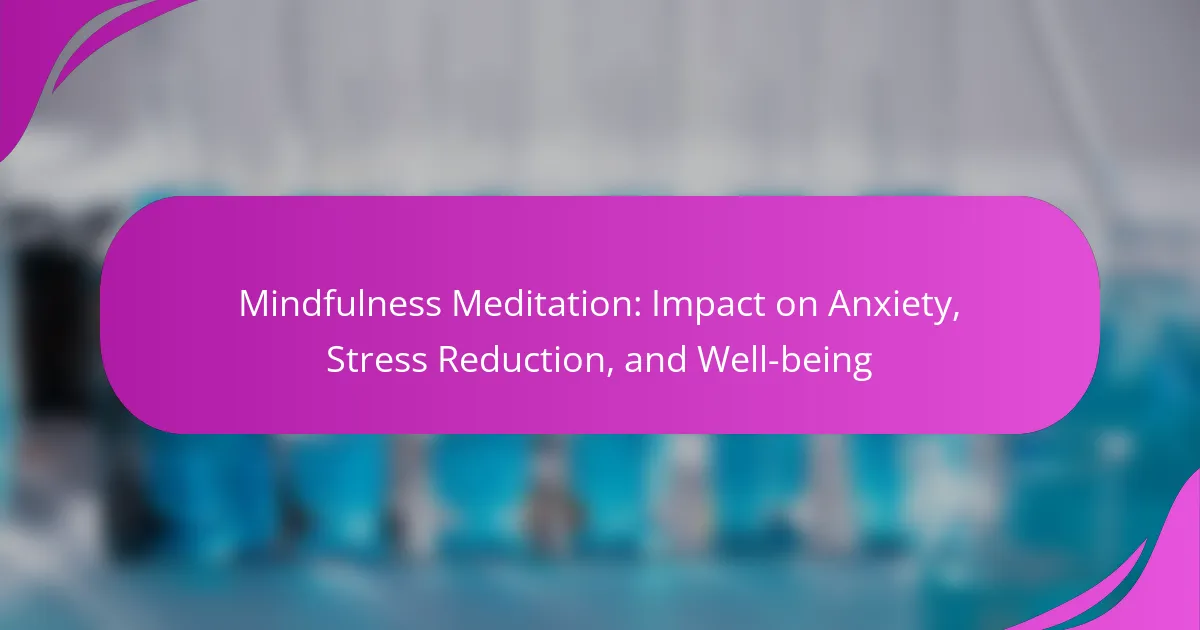Art therapy significantly enhances mental health by promoting emotional expression and reducing anxiety. This article explores the benefits of art therapy, various techniques used, and its applications in settings like schools and hospitals. By examining its unique attributes and best practices, we highlight how art therapy can effectively support individuals facing mental health challenges.
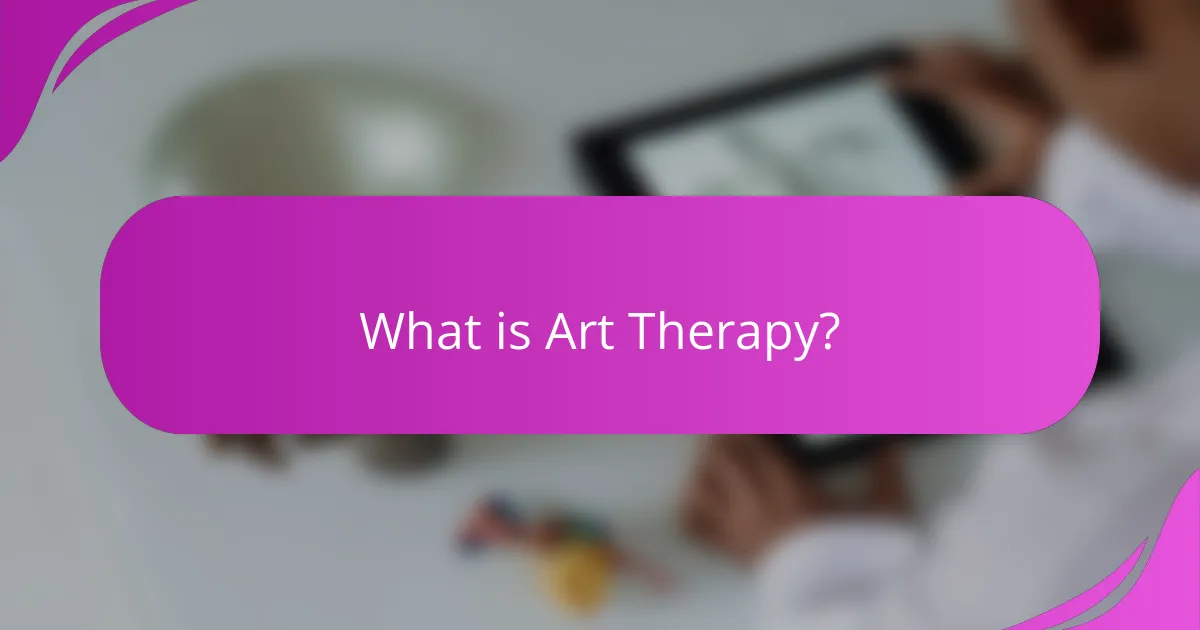
What is Art Therapy?
Art therapy is a therapeutic approach that uses creative expression to improve mental health. It offers numerous benefits, including enhanced emotional expression, reduced anxiety, and improved self-esteem. Techniques often involve drawing, painting, and sculpting, allowing individuals to explore feelings non-verbally. Applications of art therapy span various settings, including hospitals, schools, and community centers, effectively aiding those with trauma, depression, and anxiety disorders.
How does Art Therapy differ from traditional therapy?
Art therapy differs from traditional therapy by integrating creative expression into the therapeutic process. While traditional therapy often relies on verbal communication, art therapy utilizes visual arts to facilitate emotional expression and healing. This unique approach allows clients to explore feelings that may be difficult to verbalize, promoting deeper self-awareness and insight. Additionally, art therapy can engage individuals who may feel uncomfortable in conventional talk therapy settings, making it a versatile option for various populations.
What are the key principles of Art Therapy?
Art therapy relies on key principles that enhance mental health through creative expression. These principles include the therapeutic relationship, creative process, and personal meaning.
The therapeutic relationship fosters trust and safety, allowing individuals to explore emotions. The creative process encourages self-discovery and emotional release, facilitating healing. Personal meaning emphasizes individual interpretation, making art a unique reflection of one’s experiences.
Additionally, art therapy is adaptable, integrating various techniques such as drawing, painting, and sculpture, making it accessible for diverse populations. This flexibility enhances its effectiveness across different age groups and mental health conditions.

What are the core benefits of Art Therapy for mental health?
Art therapy offers significant benefits for mental health, including emotional expression, stress reduction, and improved self-esteem. It encourages individuals to communicate feelings non-verbally, fostering healing and personal insight. Studies show that art therapy can decrease symptoms of anxiety and depression, enhancing overall well-being. Unique attributes include tailored techniques that cater to individual needs, making it a versatile approach in therapeutic settings.
How can Art Therapy improve emotional expression?
Art therapy enhances emotional expression by providing a safe space for individuals to explore their feelings creatively. It allows for non-verbal communication, which can be crucial for those struggling to articulate emotions. Techniques such as painting, drawing, and sculpting facilitate self-discovery and processing of complex feelings. Studies indicate that art therapy can significantly reduce anxiety and improve emotional resilience, making it a valuable tool in mental health treatment.
What impact does Art Therapy have on anxiety and depression?
Art therapy significantly reduces anxiety and depression by fostering emotional expression through creative processes. It provides a non-verbal outlet for feelings, helping individuals process emotions and experiences. Studies show that art therapy can lower anxiety levels and improve mood, leading to enhanced mental well-being. Engaging in creative activities promotes relaxation and encourages a sense of accomplishment, which can alleviate symptoms of depression. Furthermore, art therapy’s unique attribute lies in its ability to personalize treatment, adapting to the individual’s preferences and needs, thus maximizing therapeutic benefits.
Can Art Therapy enhance self-esteem and self-awareness?
Art therapy can significantly enhance self-esteem and self-awareness. Engaging in creative processes allows individuals to express emotions, explore personal narratives, and gain insights into their thoughts and feelings. This therapeutic approach fosters a sense of accomplishment and self-acceptance, contributing to improved mental health outcomes. Research indicates that art therapy can lead to increased self-esteem by providing a safe space for self-exploration and validation of experiences. As a result, individuals often report heightened self-awareness and a better understanding of their emotional states.
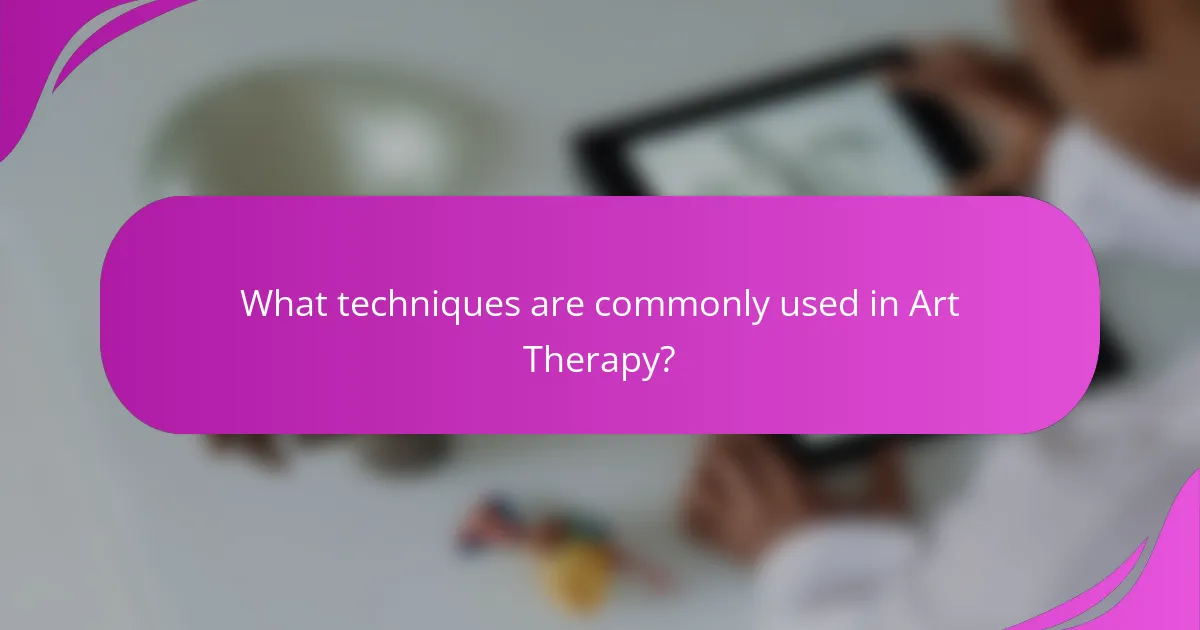
What techniques are commonly used in Art Therapy?
Art therapy commonly utilizes techniques such as drawing, painting, sculpting, and collage. These methods enable individuals to express emotions and explore thoughts non-verbally, enhancing self-awareness and emotional healing. Techniques may vary based on therapeutic goals and individual preferences. For example, guided imagery can help clients visualize emotions, while art journaling promotes reflection and personal insights.
What role does drawing and painting play in Art Therapy?
Drawing and painting are essential in art therapy as they facilitate emotional expression and healing. These creative processes allow individuals to communicate feelings that may be difficult to articulate verbally. Engaging in these activities can reduce anxiety and promote self-discovery. Research indicates that art therapy can lead to improved mental well-being, enhancing coping skills and emotional resilience. The unique attribute of art therapy lies in its ability to transform personal experiences into visual narratives, providing a safe space for exploration and reflection.
How is sculpture utilized in therapeutic settings?
Sculpture is utilized in therapeutic settings to promote emotional expression and healing. Engaging with three-dimensional art allows individuals to explore their feelings and experiences physically. This tactile interaction can decrease anxiety and enhance mindfulness. Furthermore, creating sculptures fosters a sense of accomplishment and self-worth, essential for mental health recovery. The unique attribute of sculpture as a medium lies in its ability to provide a tangible representation of abstract emotions, making it particularly effective in art therapy.
What are the benefits of using digital art in therapy?
Digital art in therapy enhances emotional expression, reduces anxiety, and fosters creativity. It provides a safe outlet for individuals to explore feelings and experiences visually. Research indicates that engaging in digital art can improve mood and promote relaxation. This form of therapy is particularly beneficial for those who may struggle with verbal communication.
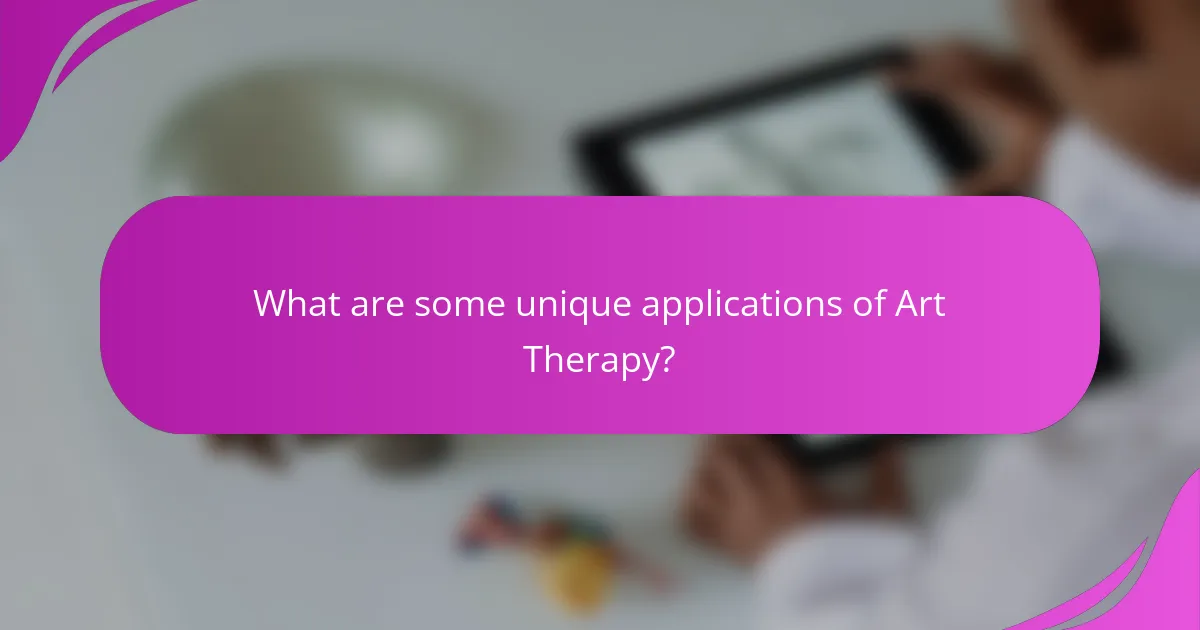
What are some unique applications of Art Therapy?
Art therapy has unique applications in various settings, enhancing mental health and well-being. It is used in schools to support students with emotional challenges, allowing them to express feelings through creativity. In hospitals, art therapy aids patients in coping with illness and trauma by promoting relaxation and self-expression. Additionally, it is utilized in rehabilitation centers to help individuals recover from addiction, fostering emotional healing through artistic activities. Art therapy also plays a role in community programs, encouraging social interaction and personal growth among participants. These diverse applications demonstrate art therapy’s versatility and effectiveness in addressing mental health needs.
How is Art Therapy applied in children’s mental health?
Art therapy is effectively applied in children’s mental health by enhancing emotional expression and communication. It provides a safe space for children to explore feelings, reducing anxiety and improving self-esteem. Techniques such as drawing, painting, and sculpting allow children to process experiences non-verbally. Research shows that art therapy can significantly decrease symptoms of depression and behavioral issues in children. Unique attributes include its adaptability to various age groups and individual needs, making it a versatile tool in therapeutic settings.
What are the uses of Art Therapy in trauma recovery?
Art therapy aids trauma recovery by facilitating emotional expression and processing. It allows individuals to communicate feelings that may be difficult to articulate verbally. Techniques such as painting, drawing, and sculpting promote self-discovery and healing. Furthermore, art therapy can enhance coping skills and reduce anxiety, fostering resilience in trauma survivors. Research shows that creative expression can lead to significant improvements in mental health outcomes.
How does Art Therapy support elderly populations?
Art therapy significantly supports elderly populations by enhancing emotional expression and reducing feelings of isolation. It fosters cognitive engagement, which can improve memory and mental agility. Techniques such as painting, drawing, and sculpting allow seniors to communicate feelings non-verbally, promoting self-esteem and social interaction. Research indicates that art therapy can alleviate symptoms of depression and anxiety, providing a creative outlet that enhances overall well-being.
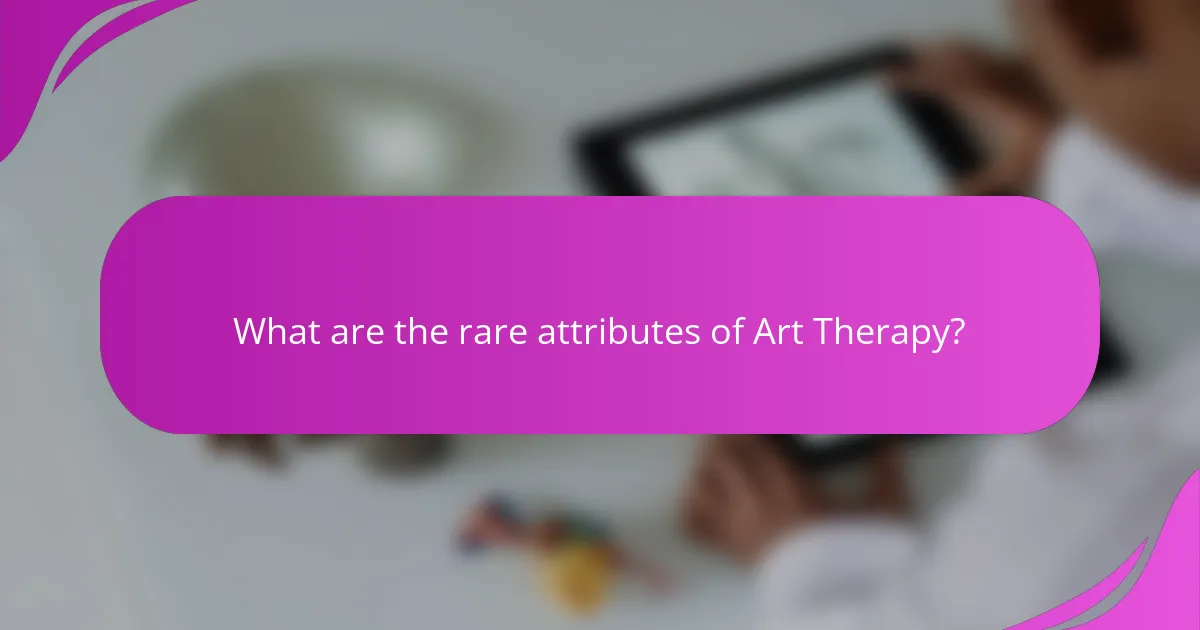
What are the rare attributes of Art Therapy?
Art therapy has unique attributes that set it apart from other therapeutic modalities. One rare attribute is its ability to facilitate non-verbal expression, allowing individuals to convey emotions and thoughts through creative processes. Another unique aspect is the incorporation of various art forms, such as painting, sculpture, and digital media, tailored to individual preferences. Additionally, art therapy can foster community engagement through group sessions, promoting social connections among participants. These rare attributes enhance the therapeutic experience and contribute to mental health improvement.
How can Art Therapy be integrated with other therapeutic modalities?
Art therapy can be integrated with other therapeutic modalities to enhance overall treatment effectiveness. Combining art therapy with cognitive-behavioral therapy (CBT) allows clients to express emotions while addressing negative thought patterns. Integrating mindfulness practices can deepen self-awareness and emotional regulation during art-making. Additionally, using art therapy alongside group therapy fosters social connections and shared experiences, promoting healing through community support. Each integration enriches the therapeutic process, addressing unique client needs and providing varied pathways for self-expression and healing.
What are the cultural considerations in Art Therapy?
Cultural considerations in art therapy include understanding diverse artistic expressions, values, and beliefs. Therapists must be aware of cultural backgrounds to ensure respectful and effective communication. This sensitivity enhances the therapeutic relationship and fosters trust, allowing clients to express themselves authentically. Additionally, recognizing cultural symbols and meanings in art can lead to deeper insights into a client’s experiences and emotions.
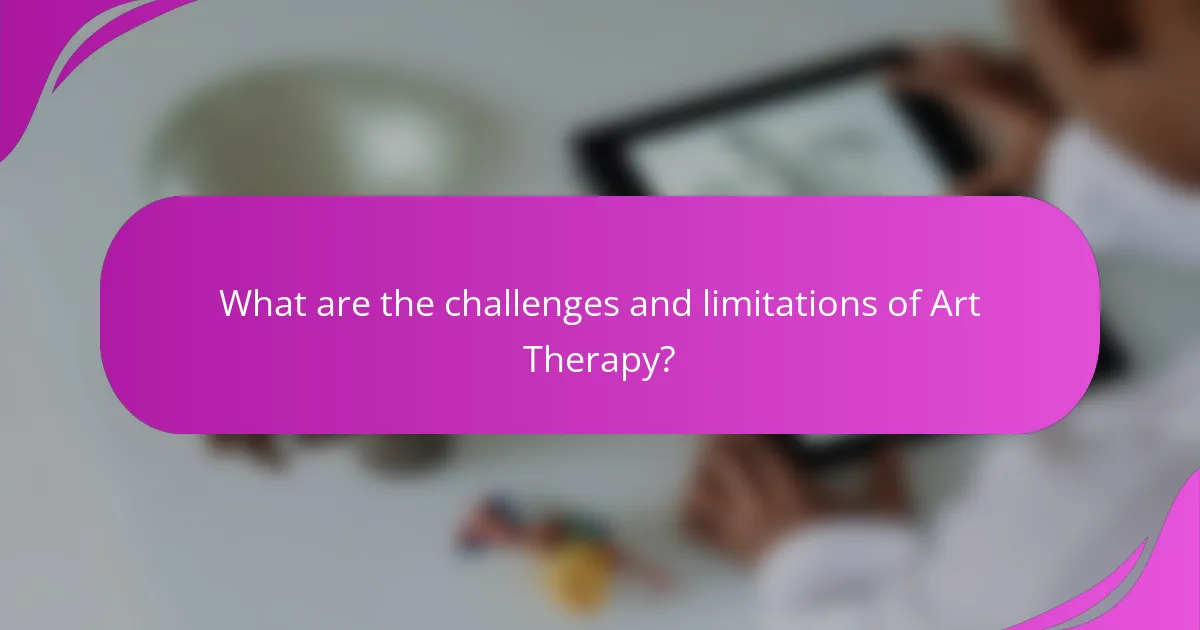
What are the challenges and limitations of Art Therapy?
Art therapy faces several challenges and limitations. These include variability in individual responses, lack of standardized practices, and potential misinterpretation of artwork. Additionally, not all clients may feel comfortable expressing themselves through art, which can limit effectiveness. Access to trained art therapists can also be a barrier, particularly in underserved areas. Furthermore, cultural differences may impact the interpretation of art, posing challenges in diverse settings.
What barriers do practitioners face in implementing Art Therapy?
Practitioners face several barriers in implementing Art Therapy, including lack of training, limited resources, and resistance from clients. Insufficient understanding of the therapeutic benefits can hinder acceptance. Additionally, administrative challenges and stigma surrounding mental health may obstruct access to Art Therapy programs.
How can misconceptions about Art Therapy affect its acceptance?
Misconceptions about art therapy can hinder its acceptance and effectiveness. Many people believe it is merely a form of entertainment rather than a legitimate therapeutic approach. This misunderstanding can lead to skepticism among mental health professionals and potential clients. As a result, art therapy may be underutilized, despite its proven benefits in enhancing emotional expression and processing trauma. Misconceptions can also create barriers to funding and support for art therapy programs, limiting access for those who could benefit. Emphasizing evidence-based outcomes and educating the public about its therapeutic value can improve acceptance.
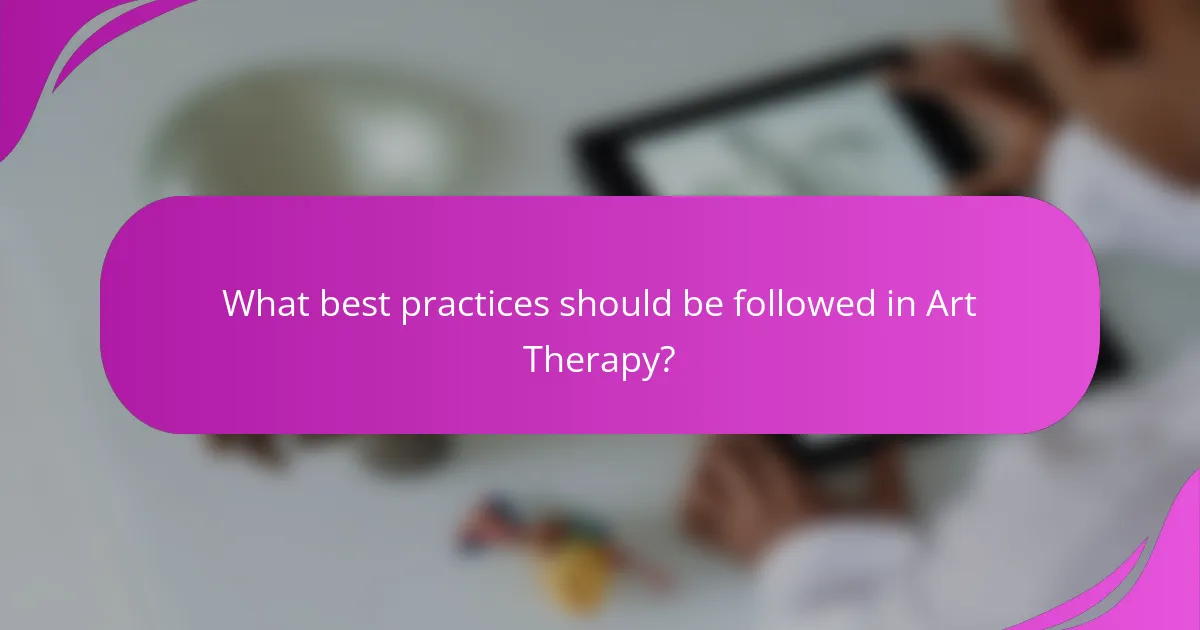
What best practices should be followed in Art Therapy?
Art therapy best practices include creating a safe environment, encouraging self-expression, and utilizing diverse materials. Establishing trust with clients enhances their engagement and willingness to explore emotions. Regularly reflecting on the therapeutic process ensures that techniques remain relevant and effective. Incorporating mindfulness can deepen the therapeutic experience, promoting relaxation and focus.
How can clients maximize the benefits of Art Therapy?
Clients can maximize the benefits of Art Therapy by actively engaging in the creative process and expressing emotions. Setting specific goals for therapy enhances focus and outcomes. Practicing regularly outside sessions reinforces skills and insights gained. Collaborating with the therapist on preferred techniques fosters a personalized experience. Exploring various art forms can uncover new perspectives and deepen self-discovery. Maintaining an open mindset allows clients to embrace the therapeutic journey fully.
What common mistakes should be avoided in Art Therapy sessions?
Avoiding common mistakes in Art Therapy sessions enhances effectiveness. Key mistakes include lack of preparation, not establishing a safe environment, ignoring client emotions, and failing to adapt techniques to individual needs. These errors can hinder therapeutic progress and diminish the benefits of art therapy. Addressing these issues ensures a more productive and supportive experience for clients.
What expert insights can enhance the effectiveness of Art Therapy?
Expert insights can enhance the effectiveness of Art Therapy by focusing on specific techniques and approaches. Incorporating evidence-based practices, such as cognitive-behavioral strategies, can improve therapeutic outcomes. Tailoring interventions to individual needs fosters engagement, while integrating mindfulness techniques enhances emotional regulation. Regular supervision and training for therapists ensure the application of best practices, maximizing client benefits. Collaboration with other mental health professionals enriches the therapeutic process, promoting a holistic approach to mental health.



